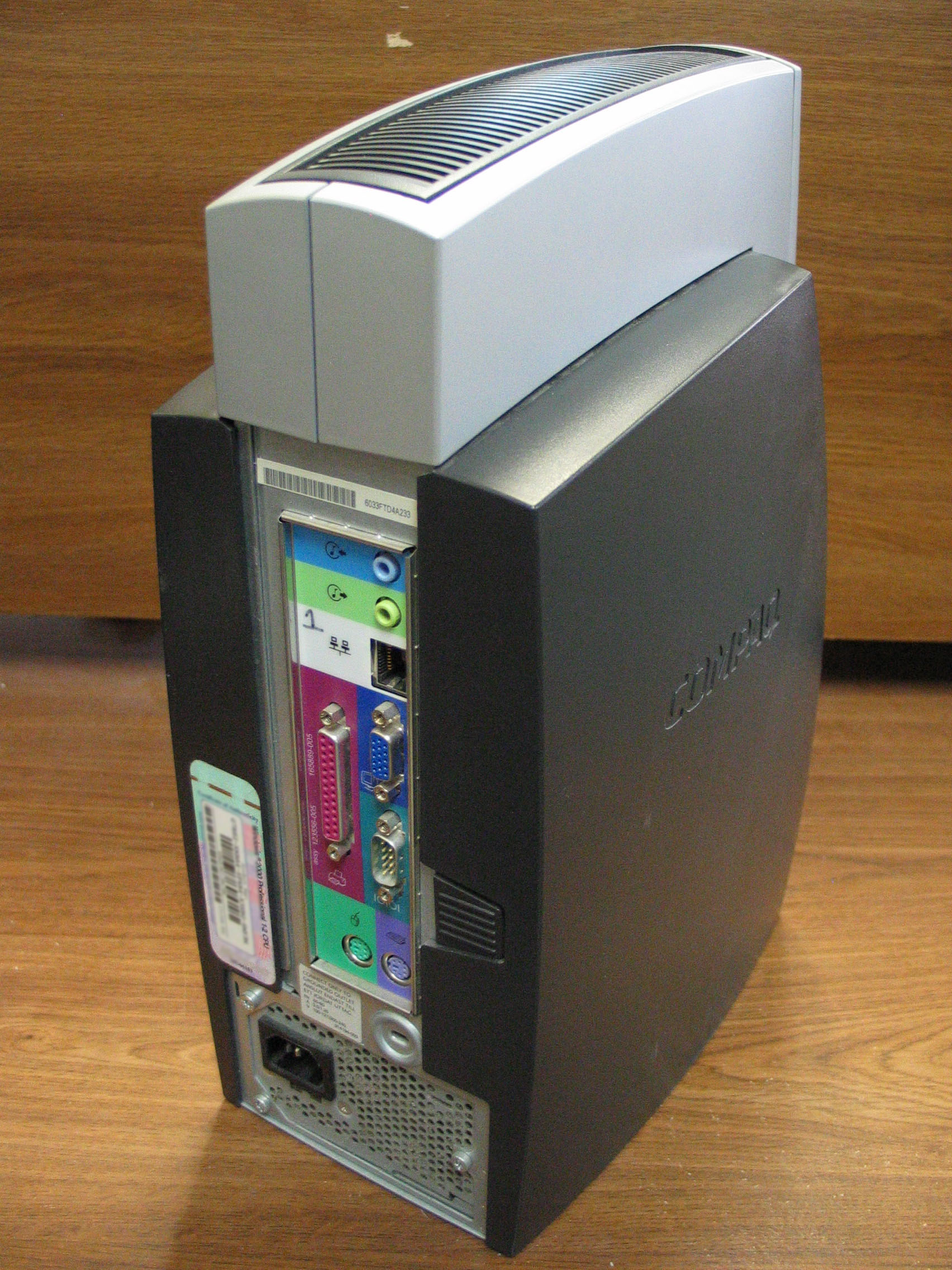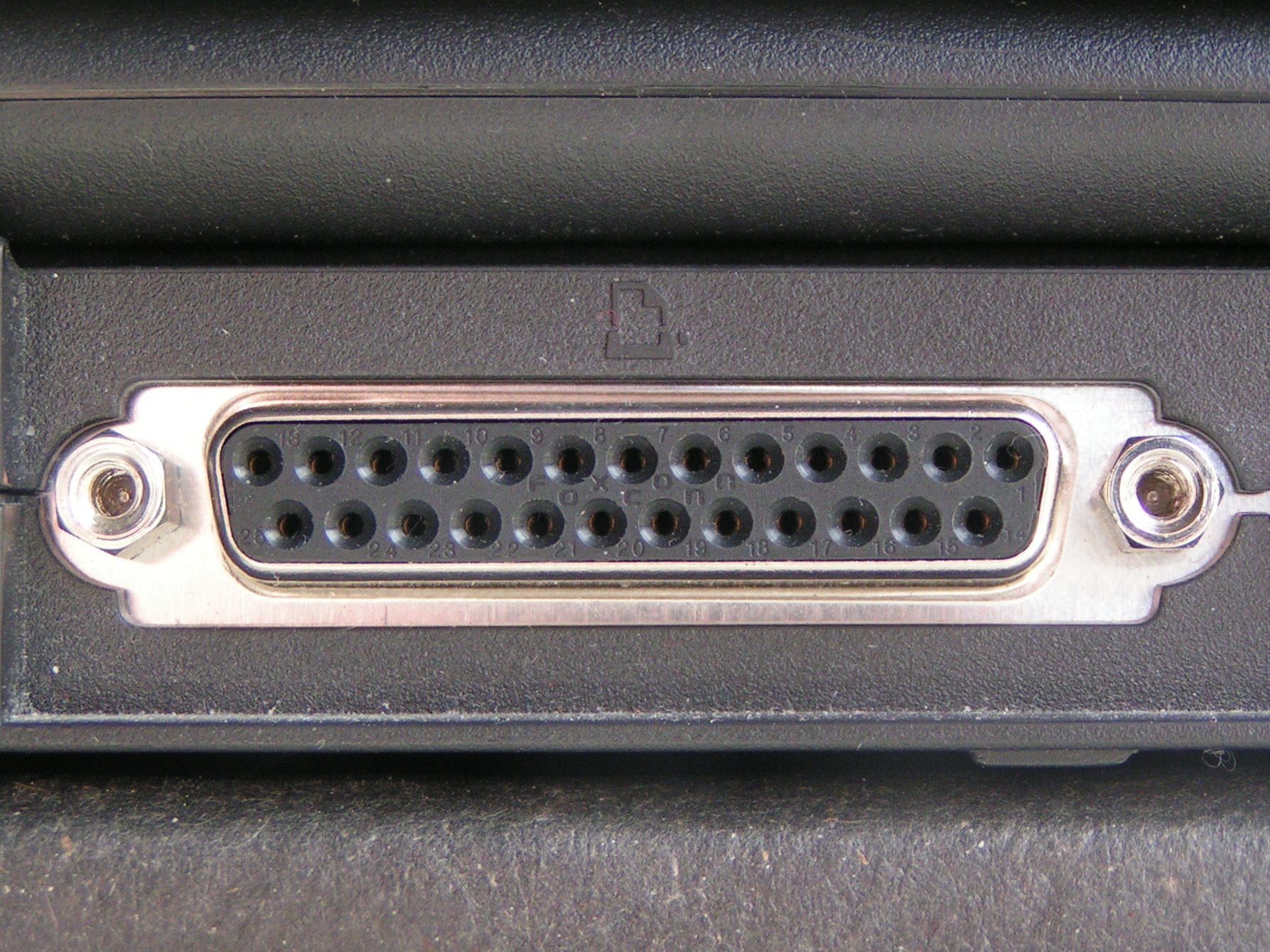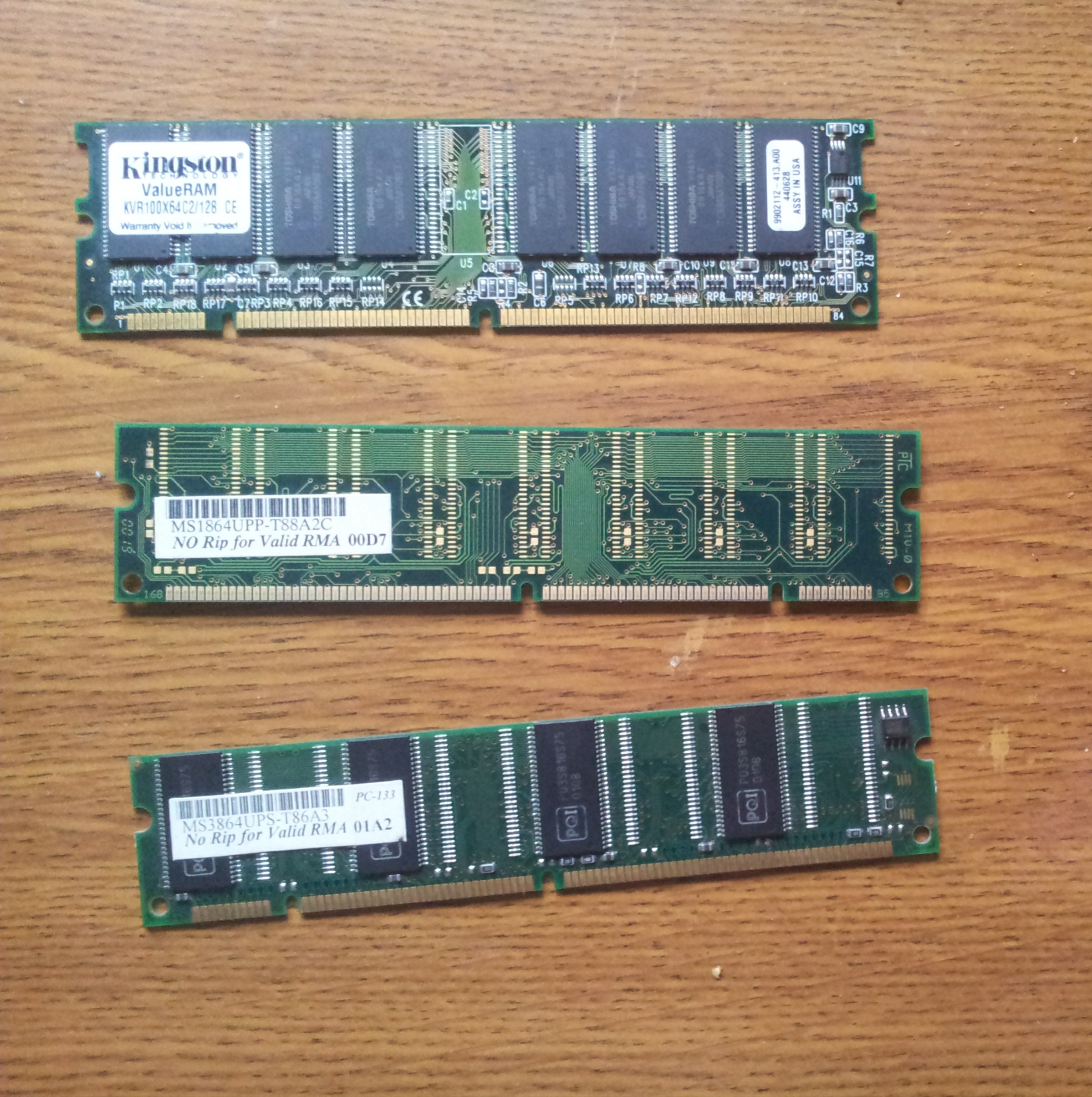|
IPAQ (desktop Computer)
The iPAQ Desktop Personal Computer in its various incarnations was a legacy-free PC produced by the Compaq Computer Corporation around the year 2000. It was inspired by the iMac, and was primarily designed to be a portable desktop computer that could be used as a simple internet-capable computer. Hardware The iPAQ had very few limitations on upgradability; hard drives, RAM, CPU and 'Multi-Bay' drives can be readily interchanged, although the iPAQ did not contain sockets for expansion cards. It featured an interchangeable 'Multi-Bay' slot that could accept a 3.5 inch LS SuperDisk drive (the only way to read a floppy disk - standard Multi-Bay floppy drives do not work), optical drives, or a secondary hard disk device. The slot was the same as those found on many Compaq Armada and many other HP/Compaq laptop computer systems. By a method of convection for cooling, these computers were commonly found in office environments due to their low noise ( dB) output. The iPA ... [...More Info...] [...Related Items...] OR: [Wikipedia] [Google] [Baidu] |
Compaq
Compaq Computer Corporation was an American information technology, information technology company founded in 1982 that developed, sold, and supported computers and related products and services. Compaq produced some of the first IBM PC compatible computers, being the second company after Columbia Data Products to legally Reverse engineering, reverse engineer the BIOS of the IBM Personal Computer. It rose to become the Market share of personal computer vendors, largest supplier of PC systems during the 1990s. The company was initially based in Harris County, Texas. The company was formed by Rod Canion, Jim Harris (entrepreneur), Jim Harris, and Bill Murto, all of whom were former Texas Instruments senior managers. All three had left by 1991 under a shakeup, which saw Eckhard Pfeiffer appointed president and CEO, serving through the 1990s. Benjamin M. Rosen, Ben Rosen provided the venture capital financing for the fledgling company and served as chairman of the board for 17 years ... [...More Info...] [...Related Items...] OR: [Wikipedia] [Google] [Baidu] |
Intel Pentium III
The Pentium III (marketed as Intel Pentium III Processor, informally PIII or P3) brand refers to Intel's 32-bit x86 desktop and mobile CPUs based on the sixth-generation P6 (microarchitecture), P6 microarchitecture introduced on February 28, 1999. The brand's initial processors were very similar to the earlier Pentium II-branded processors. The most notable differences were the addition of the Streaming SIMD Extensions (SSE) instruction set (to accelerate floating point and parallel calculations), and the introduction of a controversial serial number embedded in the chip during manufacturing. Even after the release of the Pentium 4 in late 2000, the Pentium III continued to be produced with new models introduced up until early 2003. They were then discontinued in April 2004 for desktop units and May 2007 for mobile units. Processor cores Similarly to the Pentium II it superseded, the Pentium III was also accompanied by the Celeron brand for lower-end versions, and the Xeon for ... [...More Info...] [...Related Items...] OR: [Wikipedia] [Google] [Baidu] |
Windows 2000
Windows 2000 is a major release of the Windows NT operating system developed by Microsoft, targeting the server and business markets. It is the direct successor to Windows NT 4.0, and was Software release life cycle#Release to manufacturing (RTM), released to manufacturing on December 15, 1999, and then to retail on February 17, 2000 for all versions, with Windows 2000 Datacenter Server being released to retail on September 26, 2000. Windows 2000 introduces NTFS 3.0, Encrypting File System, and basic and dynamic disk storage. Support for people with disabilities is improved over Windows NT 4.0 with a number of new Assistive technology, assistive technologies, and Microsoft increased support for different languages and Locale (computer software), locale information. The Windows 2000 Server family has additional features, most notably the introduction of Active Directory, which in the years following became a widely used directory service in business environments. Although not pre ... [...More Info...] [...Related Items...] OR: [Wikipedia] [Google] [Baidu] |
Windows 98
Windows 98 is a consumer-oriented operating system developed by Microsoft as part of its Windows 9x family of Microsoft Windows operating systems. It was the second operating system in the 9x line, as the successor to Windows 95. It was Software release life cycle#Release to manufacturing (RTM), released to manufacturing on May 15, 1998, and generally to retail on June 25, 1998. Like its predecessor, it is a hybrid 16-bit computing, 16-bit and 32-bit application, 32-bit monolithic product with the booting, boot stage based on MS-DOS. Windows 98 is World Wide Web, web-integrated and bears numerous similarities to its predecessor. Most of its improvements were cosmetic or designed to improve the user experience, but there were also a handful of features introduced to enhance system functionality and capabilities, including improved USB support and accessibility, and support for hardware advancements such as DVD players. Windows 98 was the first edition of Windows to adopt the Window ... [...More Info...] [...Related Items...] OR: [Wikipedia] [Google] [Baidu] |
USB Port
The initial versions of the USB standard specified connectors that were easy to use and that would have high life spans; revisions of the standard added smaller connectors useful for compact portable devices. Higher-speed development of the USB standard gave rise to another family of connectors to permit additional data links. All versions of USB specify cable properties. Version 3.''x'' cables, marketed as ''SuperSpeed'', added a data link; namely, in 2008, USB 3.0 added a full-duplex lane (two twisted pairs of wires for one differential signal of serial data per direction), and in 2014, the USB-C specification added a second full-duplex lane. USB has always included some capability of providing power to peripheral devices, but the amount of power that can be provided has increased over time. The modern specifications are called ''USB Power Delivery'' (''USB PD'') and allow up to 240 watts, with or without data communications capability. Initially USB 1.0 provided u ... [...More Info...] [...Related Items...] OR: [Wikipedia] [Google] [Baidu] |
PS/2 Port
The PS/2 port is a 6-pin mini-DIN connector used for connecting Computer keyboard, keyboards and computer mouse, mice to a PC compatible computer system. Its name comes from the IBM Personal System/2 series of personal computers, with which it was introduced in 1987. The PS/2 mouse connector generally replaced the older DE-9 connector, DE-9 RS-232 "serial mouse" connector, while the PS/2 keyboard connector replaced the larger 5-pin/180° DIN connector used in the IBM PC/AT design. The PS/2 keyboard port is electrically and logically identical to the IBM AT keyboard port, differing only in the type of electrical connector used. The PS/2 platform introduced a second port with the same design as the keyboard port for use to connect a mouse; thus the PS/2-style keyboard and mouse interfaces are electrically similar and employ the same communication protocol. However, unlike the otherwise similar Apple Desktop Bus connector used by Apple, a given system's keyboard and mouse port may n ... [...More Info...] [...Related Items...] OR: [Wikipedia] [Google] [Baidu] |
Serial Port
A serial port is a serial communication Interface (computing), interface through which information transfers in or out sequentially one bit at a time. This is in contrast to a parallel port, which communicates multiple bits simultaneously in Parallel communication, parallel. Throughout most of the history of personal computers, data has been transferred through serial ports to devices such as modems, computer terminal, terminals, various peripherals, and directly between computers. While interfaces such as Ethernet, FireWire, and USB also send data as a serial Stream (computing), stream, the term ''serial port'' usually denotes Computer hardware, hardware compliant with RS-232 or a related standard, such as RS-485 or RS-422. Modern consumer personal computers (PCs) have largely replaced serial ports with higher-speed standards, primarily USB. However, serial ports are still frequently used in applications demanding simple, low-speed interfaces, such as industrial automation sys ... [...More Info...] [...Related Items...] OR: [Wikipedia] [Google] [Baidu] |
Parallel Port
In computing, a parallel port is a type of interface found on early computers ( personal and otherwise) for connecting peripherals. The name refers to the way the data is sent; parallel ports send multiple bits of data at once (parallel communication), as opposed to serial communication, in which bits are sent one at a time. To do this, parallel ports require multiple data lines in their cables and port connectors and tend to be larger than contemporary serial ports, which only require one data line. There are many types of parallel ports, but the term has become most closely associated with the printer port or Centronics port found on most personal computers from the 1970s through the 2000s. It was an industry ''de facto'' standard for many years, and was finally standardized as IEEE 1284 in the late 1990s, which defined the Enhanced Parallel Port (EPP) and Extended Capability Port (ECP) bi-directional versions. Today, the parallel port interface is virtually non ... [...More Info...] [...Related Items...] OR: [Wikipedia] [Google] [Baidu] |
BIOS
In computing, BIOS (, ; Basic Input/Output System, also known as the System BIOS, ROM BIOS, BIOS ROM or PC BIOS) is a type of firmware used to provide runtime services for operating systems and programs and to perform hardware initialization during the booting process (power-on startup). The firmware comes pre-installed on the computer's motherboard. The name originates from the Basic Input/Output System used in the CP/M operating system in 1975. The BIOS firmware was originally proprietary to the IBM PC; it was reverse engineered by some companies (such as Phoenix Technologies) looking to create compatible systems. The interface of that original system serves as a ''de facto'' standard. The BIOS in older PCs initializes and tests the system hardware components ( power-on self-test or POST for short), and loads a boot loader from a mass storage device which then initializes a kernel. In the era of DOS, the BIOS provided BIOS interrupt calls for the keyboard, display, st ... [...More Info...] [...Related Items...] OR: [Wikipedia] [Google] [Baidu] |
Chipset
In a computer system, a chipset is a set of electronic components on one or more integrated circuits that manages the data flow between the processor, memory and peripherals. The chipset is usually found on the motherboard of computers. Chipsets are usually designed to work with a specific family of microprocessors. Because it controls communications between the processor and external devices, the chipset plays a crucial role in determining system performance. Sometimes the term "chipset" is used to describe a system on chip (SoC) used in a mobile phone. Computers In computing, the term ''chipset'' commonly refers to a set of specialized chips on a computer's motherboard or an expansion card. In personal computers, the first chipset for the IBM PC AT of 1984 was the NEAT chipset developed by Chips and Technologies for the Intel 80286 CPU. In home computers, game consoles, and arcade hardware of the 1980s and 1990s, the term ''chipset'' was used for the custom audio ... [...More Info...] [...Related Items...] OR: [Wikipedia] [Google] [Baidu] |
SDR SDRAM
Synchronous dynamic random-access memory (synchronous dynamic RAM or SDRAM) is any DRAM where the operation of its external pin interface is coordinated by an externally supplied clock signal. DRAM integrated circuits (ICs) produced from the early 1970s to the early 1990s used an ''asynchronous'' interface, in which input control signals have a direct effect on internal functions delayed only by the trip across its semiconductor pathways. SDRAM has a ''synchronous'' interface, whereby changes on control inputs are recognised after a rising edge of its clock input. In SDRAM families standardized by JEDEC, the clock signal controls the stepping of an internal finite-state machine that responds to incoming commands. These commands can be pipelined to improve performance, with previously started operations completing while new commands are received. The memory is divided into several equally sized but independent sections called ''banks'', allowing the device to operate on a memory a ... [...More Info...] [...Related Items...] OR: [Wikipedia] [Google] [Baidu] |
Megabyte
The megabyte is a multiple of the unit byte for digital information. Its recommended unit symbol is MB. The unit prefix ''mega'' is a multiplier of (106) in the International System of Units (SI). Therefore, one megabyte is one million bytes of information. This definition has been incorporated into the International System of Quantities. In the computer and information technology fields, other definitions have been used that arose for historical reasons of convenience. A common usage has been to designate one megabyte as (220 B), a quantity that conveniently expresses the binary architecture of digital computer memory. Standards bodies have deprecated this binary usage of the mega- prefix in favor of a new set of binary prefixes, by means of which the quantity 220 B is named mebibyte (symbol MiB). Definitions The unit megabyte is commonly used for 10002 (one million) bytes or 10242 bytes. The interpretation of using base 1024 originated as technical jargon for the byte m ... [...More Info...] [...Related Items...] OR: [Wikipedia] [Google] [Baidu] |






